
Systems of Two Linear Equations in Two Variables Video 5
Solving a system of two linear equations using a TI-84 calculator
Problem: Use a calculator to solve the following system of linear equations: \begin{align*} 5y&=3x+15\\ 0.75&x+3.75=1.25y\end{align*}

Solving a system of two linear equations using a TI-84 calculator

Explaining the format and possible solutions for a system of two linear equations

Solving a system of two linear equations using a TI-84 calculator

Explaining the format and possible solutions for a system of two linear equations

Solving a system of linear equations with two variables

Solving a system of two linear equations with two variables using the elimination method

Solving a linear equation algebraically and showing how this relates to the graph

Solving a linear equation algebraically

Solving a linear equation algebraically and showing how this relates to the graph

Discussing how to write the equation of a line through two given points

Solving a system of linear equations and giving a geometric interpretation of the solution

Graphing a line without using technology

Graphing a line without using technology

Graphing a line without using technology

Writing a function for the value of an item depreciating linearly over time

Finding the solution to a system of linear equations by graphing
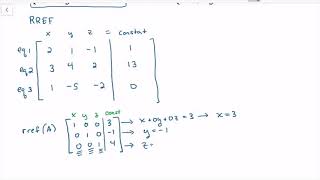
Using a TI-84 to solve a system of linear equations in three variables
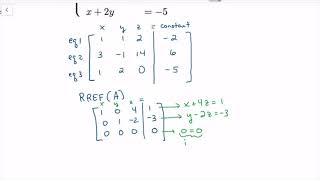
Using a TI-84 to solve a system of linear equations in three variables

Graphing the solution set of an inequality with two variables

Graphing the solution set of an inequality with two variables

Graphing the solution set of system of linear inequalities

Explaining the definition of logarithmic scale and double-log plots

Using logarithms to transform a power function into a linear function

Review of the limit definition of a derivative and calculating the derivative

Review of the limit definition of a derivative and calculating the derivative

Review of derivatives and tangent lines to functions and vector equations

Review of the limit definition of a derivative and calculating the derivative

Review of derivatives and tangent lines to functions and vector equations

Review of the limit definition of a derivative and calculating the derivative

Derivatives and tangents to curves

Find the Cartesian form and sketch the graph for the parametric equation of a line
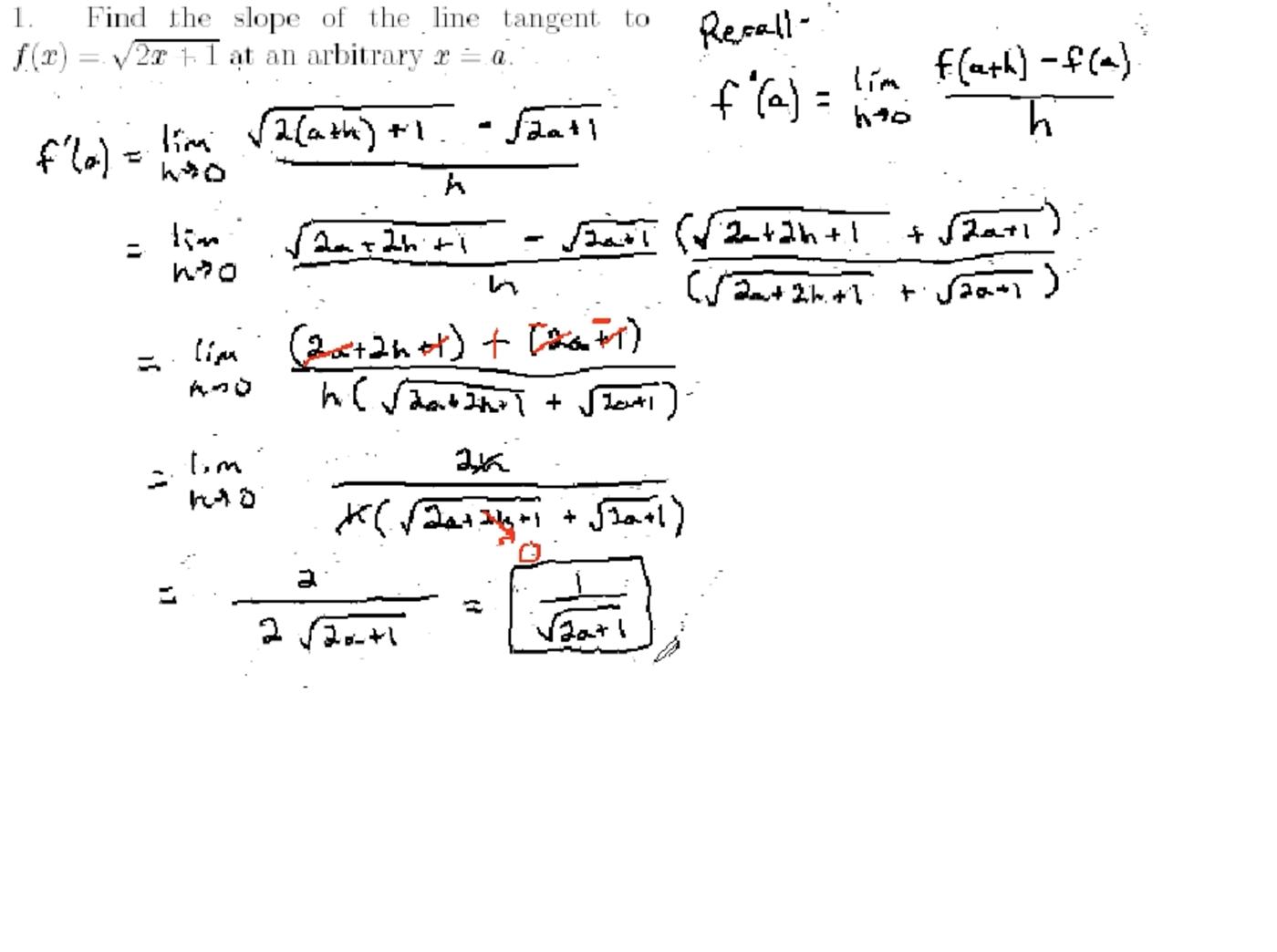
Using the limit definition to find derivatives of functions and vector functions

Review of the limit definition of a derivative and calculating the derivative

Review of the limit definition of a derivative and calculating the derivative

Review of derivatives and tangent lines to functions and vector equations

Using the limit definition to find derivatives of functions and vector functions

Using the limit definition to find derivatives of functions and vector functions

Review of the limit definition of a derivative and calculating the derivative

Review of derivatives and tangent lines to functions and vector equations

Review of the limit definition of a derivative and calculating the derivative

Review of derivatives and tangent lines to functions and vector equations

What the derivatives of a function tell us about the shape of its graph

Optimizing values in word problems

Finding the point where two lines in three-dimensional space intersect

Writing a linear equation of profit from a business word problem

Explaining the main three forms for linear equations

Discussing properties of linear functions

Discussing the types of linear graphs including horizontal and vertical lines and their properties

Explaining when a quadratic equation does not have a real solution

Explaining the graph and properties for the parent function of quadratics

Solving equations with even roots and checking the solutions

Explaining the general properties of even and odd root functions

Properties of exponential growth and decay functions

Properties of the exponential function with base e

Explaining how to solve equations with power and exponential terms

Explaining the basic properties of logarithmic functions

Discussing parent functions of rational functions and their properties

Solving a system of two linear equations in two unknowns by graphing

Using technology to solve a system of linear equations

Solving a word problem using a linear system of equations and a calculator

Determining the change in y as x increases for a line

Determining the change in x as y decreases for a line

Determining the slope of a line given points containing a variable

Writing the equation of a line that passes through two points

Finding the slope of a line through a pair of points

Writing the equation of a line with an undefined slope and a given point

Writing the equation of a line with a zero slope given a point

Finding the x and y-intercepts for a line

Solving for a constant so a line has a particular x-intercept
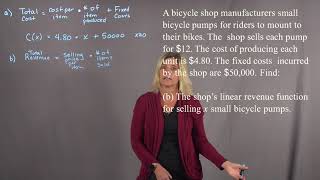
Finding linear functions for the cost, revenue, and profit of a business

Finding the linear cost function for a company

Finding the linear revenue function for a company

Finding the linear profit function for a company

Finding a linear demand equation

Finding a linear supply function

Writing a system of equations for a given word problem

Answering questions about a demand and supply word problem

Finding the change in y as x increases for a given line

Writing a linear function representing the depreciation of a car

Writing the augmented matrix for a system of linear equations

Determining if given values are solutions to a system of linear equations
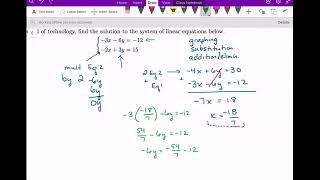
Solving a system of linear equations without using technology

Explaining how to graph linear inequalities

Graphing two linear inequalities

Sketching the solution set and finding the corner points for a system of linear inequalities

Maximizing profit subject to a set of constraints

Maximizing wages subject to a set of constraints

Using a graph to find specific values of a function

Finding the maximum revenue, maximum profit, and break even quantity for given revenue and cost functions

Calculating the future value of an investment for different compounding periods
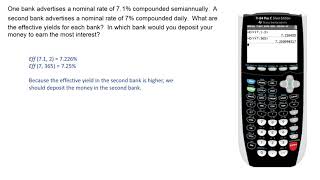
Calculating the effective yields of two compound interest rates to determine which is the better investment

Calculating the future value of an investment with a compounded interest rate

An introduction to using the TVM Solver on the TI-84 calculator

Calculating the future value of an annuity and the amount of interest earned

Calculating the quarterly payment to obtain the desired future value of an annuity

Calculating how many years at a given interest rate to save so the future value is the desired amount

Calculating how long it takes to pay off a debt with compound interest and the total interest paid

Calculating how much money a company should set aside to make retirement payments for 25 years

Calculating payments and interest for the mortgage on a house

Calculating the quarterly payments, total payments, and interest earned for a sinking fund

Calculating the payments and total interest of a loan for different lengths of time

Calculating the values in an amortization table for a loan

Calculating the values in an amortization table for a home mortgage and the equity in the home at certain times
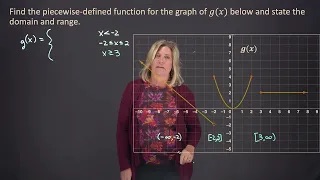
Finding the piecewise-defined function for a given graph along with its domain and range

Graphing a piecewise function

Identifying the parent function and transformations for a given graph

Identifying the parent function and transformations for a given graph

Identifying the parent function and transformations for a given graph

Identifying the parent function and transformations for a given graph

Drawing the graph of a transformed function given the original graph

Evaluating compositions of two given functions and the graph of a third function

Using the Horizontal Line Test to determine if graphs represent invertible functions

Finding limits from the graph of a piecewise function

Determining where a piecewise function is continuous from its graph

Determining where the derivative of a function does not exist from a graph

Using logarithms to transform an exponential function to a linear function

Writing a non-linear function to represent the line graphed on a semilog plot
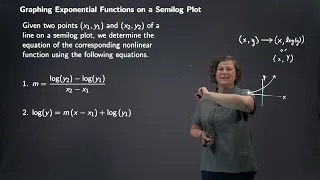
Explaining the logarithmic scale and a semilog plot

Explaining the Sandwich (or Squeeze) Theorem with a graphical example

Solving a limit at infinity using the Sandwich (or Squeeze) Theorem

Finding the equation of a line through two points

Finding the equation of a line through two points

Finding the equations of parallel and perpendicular lines

Finding the equation of a parallel line
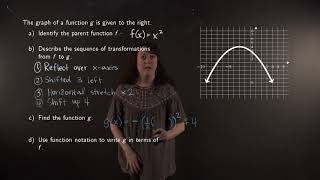
Identifying the parent function and transformations of a function

Identifying the parent function and transformations of a function

Determining the properties of a rational function and graphing it

Determining the properties of a rational function and graphing it

Graphically verifying if two functions are inverses

Restricting the domain of a function so it is one-to-one and has an inverse

Determining algebraically the inverse of a function

Determining algebraically the inverse of a function

Determining algebraically the inverse of a function

Determining properties of an exponential function

Determining properties of an exponential function
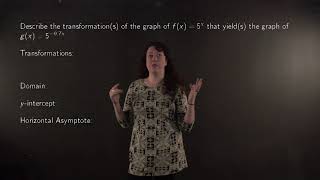
Determining properties of an exponential function

Identifying the graph of an exponential function

Determining properties of an exponential function

Determining the graph of a logarithmic function

Determining the graph of a logarithmic function

Determining the properties of a sine function and graphing it

Determining the properties of a cosine function and graphing it

Writing the equation for a sine function to match a given graph

Writing the equation for a cosine function to match a given graph

Adding and subtracting vectors graphically

Solving a linear system of equations using substitution

Solving a linear system of equations using elimination

Solving a linear system of equations

Finding the properties of a transformed tangent function and graphing it

Using a graph to evaluate a function

Determining if a function is even or odd

Cartesian equations and parametric equations of curves

Derivatives and vectors with some physics applications

Review of vector functions and parametric equations

Review of limits, continuity, and the Intermediate Value Theorem

Mean Value Theorem and using derivatives to find the shape of curves

Properties and derivatives of inverse trigonometric functions

Evaluating limits of functions

Evaluating Limits of Functions

Continuity of Functions and the Intermediate Value Theorem
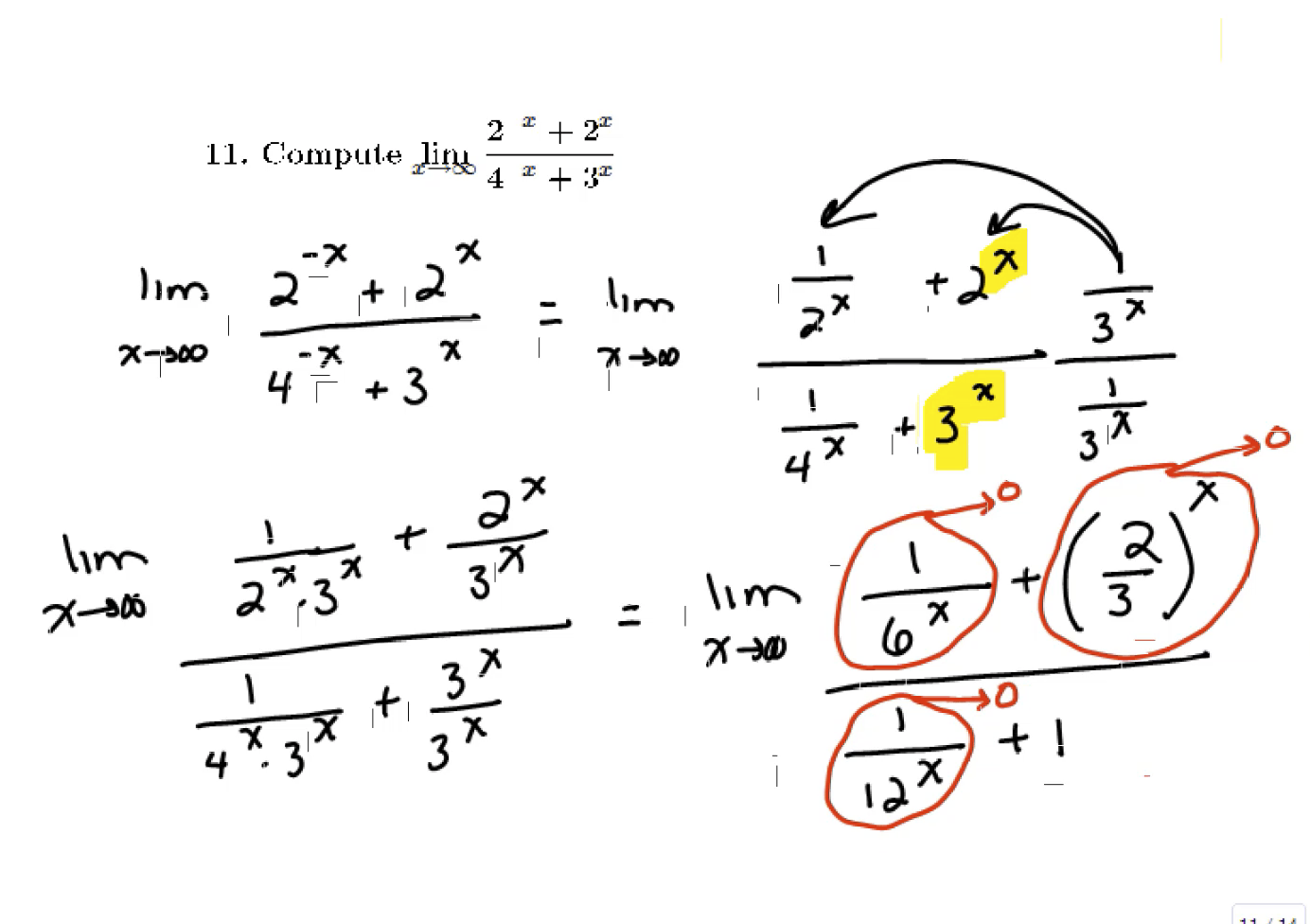
Approximation and Newton's Method, and limits and derivatives of exponential functions

Differentials, linear approximations and quadratic approximations

Approximation and Newton's Method, and limits and derivatives of exponential functions

Derivatives and vectors with some physics applications

Properties and derivatives of inverse trigonometric functions

Derivatives and vectors with some physics applications

Using derivatives to find properties of graphs
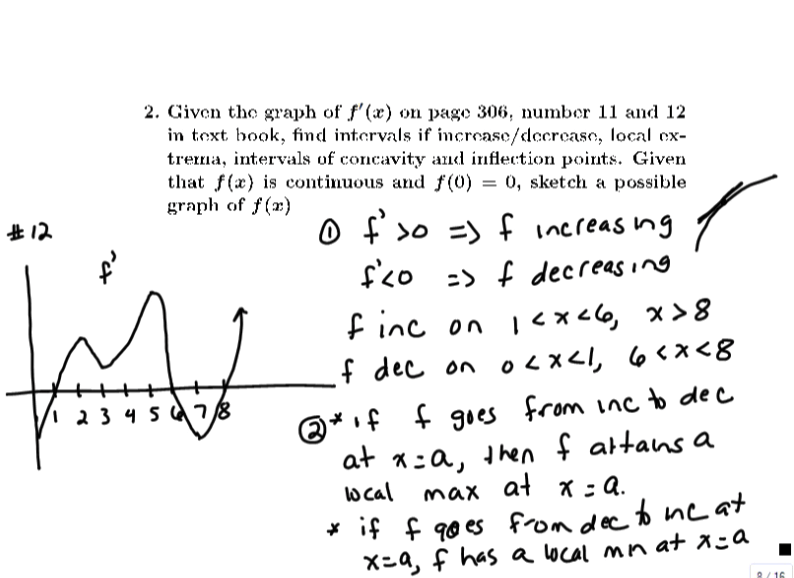
Using derivatives to find properties of graphs

Finding the distance between a point and a line using scalar projection

Converting parametric equations into a Cartesian equation and graphing

Finding a vector equation for the line through two points

Finding a parallel vector through a point

Finding a Cartesian equation for a parametric equation and graphing it

Finding a line perpendicular to a vector and passing through a point

Using the graph of a function to sketch a graph of its derivative

Finding the derivatives of compositions of functions from their graphs

Determining the properties of a function from the graph of its derivative

Finding a vector equation for the line passing through two points

Converting parametric equations into a Cartesian equation and graphing

Converting parametric equations into a Cartesian equation and graphing

Converting parametric equations into a Cartesian equation and graphing

Converting parametric equations into a Cartesian equation and graphing

Finding the area of a region bounded by two curves

Cartesian equations and parametric equations of curves

Proving facts about the derivatives of vector functions including the product rule

Derivatives and vectors with some physics applications

Derivatives and vectors with some physics applications

Review of vector functions and parametric equations

Review of limits, continuity, and the Intermediate Value Theorem

Mean Value Theorem and using derivatives to find the shape of curves

Properties of inverse trig functions and the derivative of arctangent

Properties and derivatives of inverse trigonometric functions

Evaluating limits of functions

Evaluating limits of functions and using the Squeeze Theorem

Proving limits using the epsilon-delta definition

Proving a piecewise function and a polynomial are continuous

Continuity of Functions and the Intermediate Value Theorem

Approximation and Newton's Method, and limits and derivatives of exponential functions

Proving facts about differentials including a product rule

Differentials, linear approximations, and quadratic approximations

Examples involving the tangent line to an exponential function and finding the derivative of hyperbolic cosine

Approximation and Newton's Method, and limits and derivatives of exponential functions

Derivatives and vectors with some physics applications

Properties and derivatives of inverse trigonometric functions

Properties of inverse trig functions and the derivative of arctangent

Using derivatives to find properties of graphs

Using derivatives to find properties of graphs

Proving L'Hospital's Rule and using it to evaluate limits

Proving and then applying the Fundamental Theorem of Calculus

Showing how an equation in three dimensional space represents a plane

Finding an equation of the plane containing two given lines in three-dimensional space
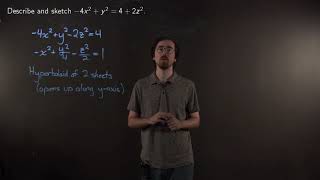
Identifying the equation of a hyperboloid and sketching its graph

Identifying the equation of a cone in three dimensions and sketching its graph

Finding and sketching the domain of a function of two variables

Finding and sketching the domain of a function of two variables

Sketching the graph of a function of two variables

Sketching the graph of a function of two variables

Sketching the level curves of a function of two variables

Sketching the level curves of a function of two variables

Describing the level surfaces of a function of three variables

Using the method of Lagrange multipliers to find the extreme values of a function subject to a constraint

Evaluating a double integral over a given region

Evaluating a double integral over a given region

Evaluating a double integral and sketching the region of integration

Changing the order of integration for a double integral

Evaluating a double integral by reversing the order of integration

Setting up double integrals of Type I and II to give the volume of a solid under a surface

Evaluating a double integral over a circular region by changing to polar coordinates

Evaluating a double integral by changing to polar coordinates

Evaluating a double integral by changing to polar coordinates

Converting a double integral to a double integral in polar coordinates

Writing an iterated integral in polar coordinates that gives the volume of the solid that lies below a paraboloid

Writing an iterated integral in polar coordinates that gives the volume of the solid bounded by a cone

Writing an a triple integral over a given solid as an iterated integral

Evaluating a triple integral over a solid bounded by given surfaces

Writing an iterated integral that gives the volume of a solid

Evaluating a triple integral over a solid bounded by elliptic paraboloids

Writing a triple integral as an iterated integral in cylindrical coordinates

Converting an iterated triple integral into cylindrical and spherical coordinates

Using an iterated integral in spherical coordinates to find the volume of a solid

Evaluating a triple integral for a given solid by writing an iterated integral in spherical coordinates

Evaluating a line integral along a curve in space

Using Python to find the equation of the tangent line to a curve and graphing the result

Using Python to plot an implicit curve and find a tangent line using implicit differentiation

Using Python to numerically estimate a limit, graphically estimate a limit, and find the exact limit

Using Python to find the tangent line to a parametric equation and plot the two graphs

Graphing a piecewise function using Python

Solving a multistep word problem in Python and graphing the resulting function

Explaining the concepts of existence and uniqueness for solutions of systems of equations

Solving a system of equations with three equations and three variables

Solving a two systems of equations

Using the Gauss-Jordan algorithm to solve a system of equations

Solving a system of equations by row reducing the augmented matrix

Solving a matrix equation using the inverse of the matrix

Evaluating iterated integrals over the same region but with different orders of integration

Writing and then solving an iterated integral for a given region

Using double integrals to calculate the weight of a plate given its density and size
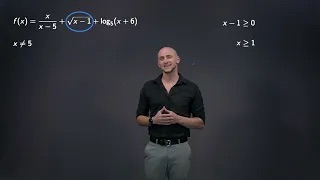
Finding the domain of a function with a denominator, square root, and logarithm

Finding the domain of a function with a natural logarithm and denominator

Finding the domain of a function with a square root in the denominator

Finding the domain of a function with a root and a logarithm in the denominator
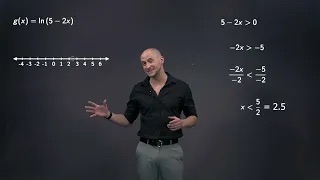
Finding the domain of a logarithmic function

Finding the domain of even and odd roots
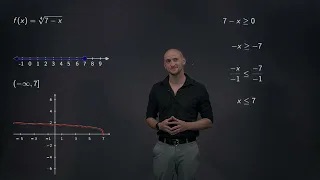
Finding the domain of functions with even and odd roots

Finding the domain of several rational functions

Finding the domain of a rational function

Explaining how to find any holes and vertical asymptotes of a rational function

Finding the domain of a rational function using factoring

Explaining domain restrictions for denominators, even roots, and logarithms

Explaining the standard form for a quadratic equation and the possible number of solutions

Solving quadratic equations with the difference of two squares formula
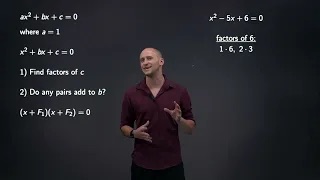
Solving quadratic equations by factoring

Solving a quadratic equation by factoring

Solving a quadratic equation by factoring

Solving quadratic equations with the quadratic formula and discussing the number of possible solutions
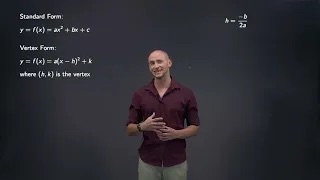
Discussing properties of quadratic functions including the vertex, domain, range, and end behavior

Solving equations with odd radicals

Solving equations with multiple radicals
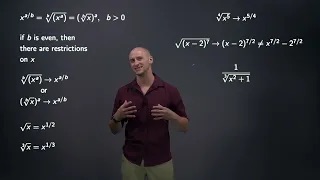
How to rewrite radical terms as power terms

Explaining how to solve radical equations and then solving example problems

Solving equations with exponential terms

Solving equations with base e exponential terms
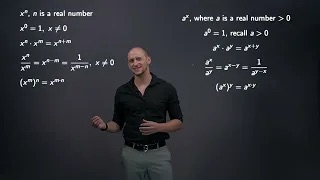
Properties of exponents applied to power and exponential expressions

Properties of multiplying and simplifying power and exponential expressions

Properties of exponents applied to power and exponential expressions

Simplifying power and exponential expressions using properties of exponents

Simplifying power and exponential expressions using properties of exponents

Simplifying power and exponential expressions using properties of exponents

Simplifying an expression with both power and exponential functions using properties of exponents

Explaining the terminology and rules of logarithms

Expanding logarithmic expressions using logarithm rules

Condensing a logarithmic expression into a single logarithm

Explaining how to solve logarithmic equations

Solving logarithmic equations with a single logarithm term

Solving logarithmic equations with multiple logarithm terms

Solving logarithmic equations with multiple logarithm terms on both sides

Finding horizontal asymptotes for rational functions
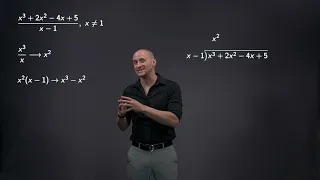
Explaining how to do polynomial long division

Finding horizontal asymptotes for rational functions

Determining the end behavior and horizontal asymptotes for rational functions

Explaining basic algebraic operations for fractions

How to simplify rational expressions

Adding and subtracting rational expressions by finding a common denominator

Explaining how to multiply and divide rational expressions

Performing algebraic operations with rational expressions and simplifying the answer

Solving equations that contain rational expressions

Solving an equation that contains rational expressions

Solving an equation that contains rational expressions

Solving a system of equations by using the Gauss-Jordan algorithm to row reduce the augmented matrix

Solving a system of equations by using the Gauss-Jordan algorithm to row reduce the augmented matrix

Solving a system of equations by using the Gauss-Jordan algorithm to row reduce the augmented matrix

Solving a system of equations by using the Gauss-Jordan algorithm to row reduce the augmented matrix

Solving a system of equations by using the Gauss-Jordan algorithm to row reduce the augmented matrix

Solving a system of equations by using the Gauss-Jordan algorithm to row reduce the augmented matrix

Solving a system of equations by using the Gauss-Jordan algorithm to row reduce the augmented matrix

Solving a system of equation by writing it as a matrix equation and using the matrix inverse

Introducing functions of several variables and level curves

Evaluating and then finding and sketching the domain of a function of two variables

Finding and sketching the domain of a function of two variables

Sketching the level curves for a function of two variables

Sketching the level curves for a function of two variables

Sketching the level curves for a function of two variables

Finding all local extrema and saddle points for a function of two variables

Explaining that a graph is a collection of vertices and edges

Drawing a graph to depict a bus route

Counting the vertices and edges from a graph

Identifying the adjacent vertices in a graph

Finding two different paths between vertices in a graph

Determining if a list of vertices in a graph is a path, circuit, Euler path, Euler circuit, or none of the above

Determining if a list of vertices in a graph is a path, a circuits, an Euler path, an Euler circuit, or none of the above

Determining if a list of vertices in a graph is a path, a circuits, an Euler path, an Euler circuit, or none of the above

Determining if a list of vertices in a graph is a path, a circuits, an Euler path, an Euler circuit, or none of the above

Determining if a list of vertices in a graph is a path, a circuits, an Euler path, an Euler circuit, or none of the above

Determining if a list of vertices in a graph is a path, a circuits, an Euler path, an Euler circuit, or none of the above

Explaining Euler's Theorem on when a graph has an Euler path or Euler circuit

Finding the valence of each vertex in a graph

Explaining Hamiltonian Circuits and paths, the Method of Trees to find them, and the number of Hamiltonian circuits for complete graphs

Determining if a graph has a Hamiltonian path, Hamiltonian Circuit, or neither

Determining if a graph has a Hamiltonian path, Hamiltonian Circuit, or neither

Determining if a graph has a Hamiltonian path, Hamiltonian Circuit, or neither

Determining if a graph has a Hamiltonian path, Hamiltonian Circuit, or neither

Using the method of trees to find all Hamiltonian circuits of a graph starting at a given vertex

Determining if a graph is a complete graph

Determining if a graph is a complete graph

Determining if a graph is a complete graph

Determining if a graph is a complete graph

Finding two spanning trees for a graph

Finding the equation of a line perpendicular to a vector in \(R^2\)

Introducing functions of several variables and level curves

Explaining matrix operations including addition and multiplication

Solving a system of linear equations with three equations and three variables

Determining the solutions of a system of equations depending on the value of the constants

Defining linear independence for a set of vectors

Determining if three vectors are linearly independent

Explanation of graphs for data and which are appropriate for categorical or numerical data

Using back substitution to solve a system of linear equations

Determining which values for the constants in a system of equations make the system consistent

Solving a system of three linear equations with three unknowns

Solving a system of linear equations by putting the corresponding augmented matrix in reduced row echelon form

Solving a system of linear equations by putting the corresponding augmented matrix in reduced row echelon form

Solving a system of linear equations by putting the corresponding augmented matrix in row echelon form

Solving a system of linear equations by putting the corresponding augmented matrix in reduced row echelon form

Solving a system of linear equations by putting the corresponding augmented matrix in reduced row echelon form

Solving a word problem using a linear system of equations

Solving a word problem by writing it as a system of linear equations

Determining if ordered pair are solutions to a system of linear equations

Determining how many solutions systems of equations have without solving or graphing

Solving for a coefficient so that a linear system has exactly one solution

Solving a system of two linear equations in two unknowns by graphing

Solving a system of two linear equations in two unknowns by graphing

Solving a system of two linear equations in two unknowns by substitution

Solving a system of two linear equations in two unknowns by substitution

Solving a system of two linear equations in two unknowns using addition

Solving a system of two linear equations in two unknowns using addition

Writing a system of linear equations for a word problem

Writing an augmented matrix for a system of linear equations

Writing a system of linear equations that corresponds to an augmented matrix

Solving a system of linear equations using the Gauss-Jordan Elimination Method

Solving a system of linear equations using the Gauss-Jordan Elimination Method

Finding the coordinate vector of a quadratic given a basis for the vector space

Determining if a graph represents a function and finding the domain and range

Writing the equation of a line passing through two points

Writing the equation of a line through two points in slope-intercept form

Writing the equation of a graphed line in standard form

Finding the inverse of a linear function and its domain

Solving a system of two linear equations using the method of substitution

Solving a system of two linear equations using the method of substitution

Solving a system of two linear equations

Solving a system on two equations where one is linear and one is quadratic